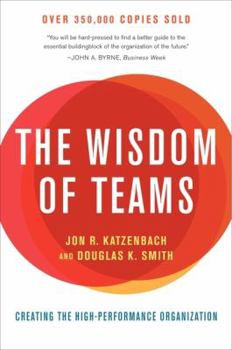The Wisdom of Teams: Creating the High-Performance Organization
Select Format
Select Condition 
Book Overview
The bestselling book that explores the remarkable benefits of teams at all levels of the organization. A look at the 30 virtues of good business that have inspired success in thousands of leaders, by... This description may be from another edition of this product.
Format:Paperback
Language:English
ISBN:0060522003
ISBN13:9780060522001
Release Date:February 2003
Publisher:HarperBusiness
Length:352 Pages
Weight:0.62 lbs.
Dimensions:0.9" x 5.3" x 7.9"
Customer Reviews
5 ratings
Exactly what I ordered
Published by Thriftbooks.com User , 14 years ago
This book came in on time, exactly as I needed it, and wonderfully priced. Loved this seller
The Wisdom of Teams Displays Much Wisdom
Published by Thriftbooks.com User , 16 years ago
This book is an excellent read for anyone with responsibilities for leading groups of people to attain desired and sometimes even extraordinary outcomes within their organization. The insights revealed here are a critically important option for organizations that wish or need to attain productivity beyond what can be realized from the sum of individual contributions. Understanding the discipline of real teams can turn someone with average leadership abilities and potential into an extraordinary leader.
How to form high-performance teams
Published by Thriftbooks.com User , 17 years ago
What's nice about Jon R. Katzenbach and Douglas K. Smith's book is their willingness to name the truth. They know that everyone pays lip service to teams, but few people act like they truly value teams - and fewer still actually know how teams really work. The authors point out where the hype lies and what it is hiding. Then they go a step farther. They provide a manual for creating what executives say they want: high-performance teams. They illustrate their suggestions, insights and guidelines with a lot of stories of real-world teams, focusing on what makes them work. Their rules are so clear that they leave little room for protecting any cherished illusions. As a result, we find that those readers who are willing to act upon the book's counsel will get the most from it. If you're seriously interested in diagnosing nonperforming teams and creating ones that perform, you'll enjoy this book. And, if you think you're already doing everything right, but your team mysteriously just isn't working...this may solve the puzzle.
A strong working guide to team development and support.
Published by Thriftbooks.com User , 25 years ago
This book is the result of research into why teams are important, what separates effective from ineffective teams, and how organizations can tap the effectiveness of teams to become high-performance organizations. Liberally citing research efforts in 47 specific organizations, Katzenbach and Smith share their insights into what makes teams work.They emphasize teams as an important part of a three part cycle leading to a high-performance organization: a) shareholders who provide opportunities, b) employees who deliver value, and c) customers who generate returns. The performance targets in the high-performance organization are multidimensional, impacting all three cyclic contributors. Teams provide real benefits to employees, the result being an impact throughout the cycle. If employees increase the value they deliver, customers will increase the return, allowing shareholders to increase the opportunities available to employees.Central to the thesis is their defini! tion of team, concentrating on "a small number of people with complementary skills who are committed to a common purpose, performance goals, and approach for which they hold themselves mutually accountable." [45] The distinction is far more than semantic. Working groups who do not share all of these characteristics are not to be considered teams. "Unlike teams, working groups rely on the sum of 'individual bests' for their performance. They pursue no collective work products requiring joint effort. By choosing the team path instead of the working group, people commit to take the risks of conflict, joint work-products, and collective action necessary to build a common purpose, set of goals, approach, and mutual accountability" [85] Katzenbach and Smith aren't completely negative toward working groups. On the contrary, they cite numerous situations in which the working group offers the most effective approach. But for turning ourselves into high-performanc! e organizations, the limitations of working groups must be ! overcome, and the power of teams must be harnessed, through increased risk. "People who call themselves teams but take no such risks are at best pseudo-teams." [85] THE WISDOM OF TEAMS describes a Team Performance Curve that correlates team effectiveness against the performance impact of the team, resulting in the organizational path from working group, to pseudo-team, to potential team, to real team, and ultimately to high-performance team. The working group describes the organization of least team effectiveness, although not without performance impact. The performance of working groups, in fact, can be very effective owing to the individual contributions of the group members. The pseudo-team - high team effectiveness, but usually less performance effectiveness - "has not focused on collective performance and is not really trying to achieve it." [91] The result is an organization that produces fewer results because of the forced team interactions. Th! e members are actually
Wisdom of Teams a valuable reference for all organizations
Published by Thriftbooks.com User , 26 years ago
A must read for organizations, both business and government wishing to utilize the strength of teams to further performance and accountability.





